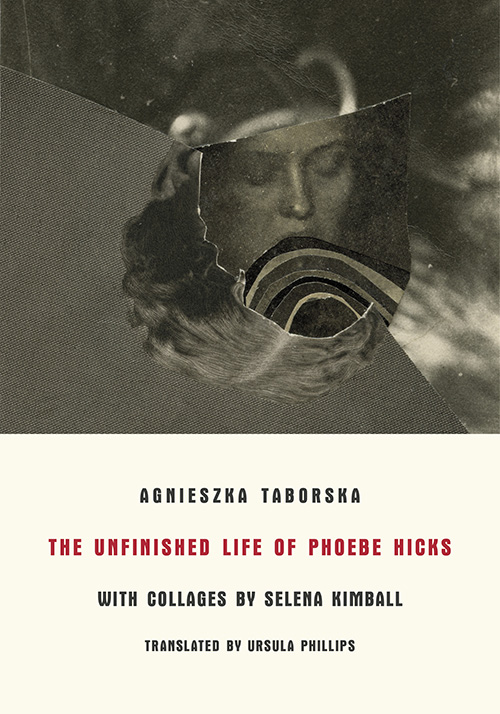| |

book view

also by the author and artist:
The Dreaming Life of
Leonora de la Cruz
a short film based on the book here
author events:
Tuesday, May 20, 2025, 7 .pm.
Riffraff Bookstore & Bar
60 Valley Street
Unit 107A
Providence, RI
info here
|
|
the unfinished life of phoebe hicks
by Agnieszka Taborska
translated from the Polish by Ursula Phillips
collage artwork by Selena Kimball
Phoebe Hicks owes her unexpected career as a spiritualist to a photograph taken of her through
her bedroom window after having eaten spoiled clams. What comes out of her mouth is taken to
be ectoplasm, and word spreads that she is able to commune with the dead. As the prototype for the
medium, she establishes the standard for how a séance should be conducted during the sessions
held in her Providence, Rhode Island, home where a growing number of curious participants witness
materializations of such figures as Ivan the Terrible, Harry Houdini, Catherine the Great, Hatshepsut,
Elizabeth Báthory, and a host of others. Told as a compilation of episodes conjoined with Selena
Kimball’s haunting collages, The Unfinished Life of Phoebe Hicks is a feminist surrealist
exploration of the rise of Spiritualism and the role of the medium in 19th-century America alongside
the expectations, and constraints, imposed on women.
Excerpt posted by TSP

Frequent references to Victorian sexuality—from the corset to nocturnal emissions of ectoplasm—contribute to the work’s
saucy sense of humor, as well as a larger statement about the role of Spiritualism in the history of women’s emancipation. As the narrator
points out, seances and other such performances allowed women to speak publicly and subvert patriarchal social norms.
|
— Jess Jensen Mitchell, Full Stop
|
This book – atmospherically interspersed with collages by Selena Kimball – stays with you long
after the seance is over.
|
— Mathilde Montpetit, The Berliner
|
Presented as a serious account—albeit with a healthy amount of wry humour—of the role of this somewhat mysterious medium in the early years of
spiritualist practice, the portrait that emerges is of a woman for whom the boundary between the world of the spirit and the world of the flesh has become somewhat permeable.
|
— Joseph Schreiber, roughghosts
|
What is not strange, what feels contemporary about this fictionalized biography are the reasons why almost any woman without economic and
social security would become a medium: In their “trance” stage, with spirits speaking through them, mediums could say things to their guests they otherwise couldn’t
get away with. A woman could be “odd” and not have to worry satisfying a whole set of social conventions that otherwise would leave her destitute. |
— Tom Bowden, Book Beat
|
Surreal, funny, unnerving, thought-provoking and a wonderful read from beginning to end, The Unfinished Life of Phoebe Hicks is
a marvellous book and I highly recommend it! |
Kaggsy's Bookish Ramblings
|
Agnieszka Taborska, otherwise innocent, has, during her annual pilgrimage into “the murky back-streets of Providence,” shamelessly consorted with the
spirits of such infamous locals as Poe, Lovecraft, and Hawkes, giving spiritual birth to the charmingly eerie nineteenth-century medium, Phoebe Hicks. Phoebe’s story, which,
the author says, “seems to belong more to dream than reality,” is a delightful postmodernist mix of fiction and history, hovering delicately between parody and mystery.
Taborska’s fictional character Leonora de la Cruz makes a guest appearance, Harry Houdini challenges Phoebe to a kind of duel, and Alain Resnais, we’re told, had intended
to make Phoebe the heroine of his 20th-century film Providence, scared off perhaps by her “disturbing ambiguity.” Phoebe is by turns a genuine communicant with the spiritual
world, a fraud, an artist, a feminist, a psychiatrist, a lunatic. She can also be, thanks to her ethereal deadpan humor, very funny. |
— Robert Coover
|
Agnieszka Taborska and artist Selena Kimball’s fictional heroines are clairvoyant women whose internal visions are projected externally through art and are conditioned by the scientific contexts of their eras. |
— New Literature from Europe
|
It turns out that spiritualism is not so far from surrealism as it might seem. The surrealists, using their imagination, tried to break the shackles of social order, abolish the binding rules,
and get out of the roles imposed from above. This transgressive element is equally important in the case of spiritualist séances, as Taborska notes, such a séance could be for the medium "entering with impunity
roles inaccessible to her in waking life." |
— Sarah Nowicka, Art Papier
|
It is a story about women's powers, or the career paths available to women at that time. About the eroticism hidden behind Victorian morality. About our desire for the extraordinary. |
— Kinga Dunin, Journal of Opinions
|
The spirit of surreal eeriness seems to coexist quite well with the ghosts that haunt our heads as well. |
— Mark Zaleski, Biweekly.com
|
|
|
 |
|

ISBN 9788088628019
124 pp., 14 x 20 cm
softcover with flaps
28 color collages
fiction : art : surrealism
RRP: £14 • US$20
publication:
UK/Europe: July 2024
US : November 2024
Order directly:
airmail postage & handling incl.
also available from:
Wordery
Bookshops
Bookshop.org
Amazon US
Amazon UK
Central Books
e-book [978-80-88628-34-7]
Amazon US
Amazon UK
Amazon Canada
Amazon Australia
Amazon Germany
Amazon Japan
|